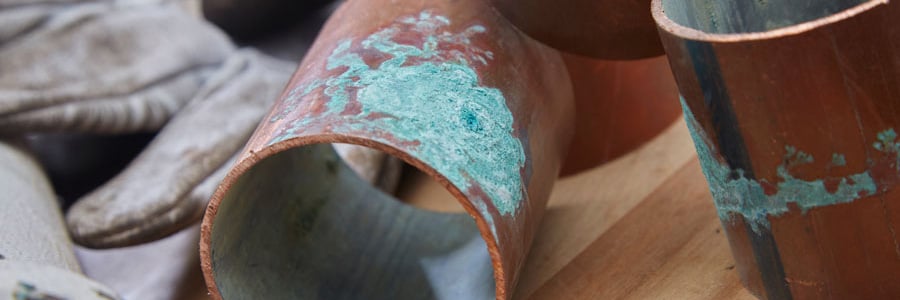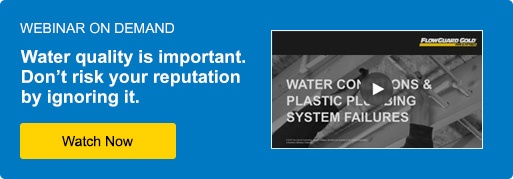
By: Jonathan Simon on June 19th, 2017
High Levels of Copper in California Condos Sheds Light on Common Water Quality Issue
Recently, dangerously high levels of copper were found in several luxury condos built within the last decade, prompting city officials to take action and caution residents against drinking and cooking with tap water.
According to an article in the Santa Barbara Independent, water-quality tests performed by both city analysts and private consultants found copper levels in the private residences well in excess of what would be considered safe for a public distribution system. Shockingly though, testing showed that water in the public supply was well within public safety limits.
How could this be?
The answer lies within the copper plumbing used within the condos themselves. Copper piping can corrode when exposed to certain water conditions, including low pH, low mineral content (aggressive) water, or the presence of various chlorine-based disinfectants used to prevent the growth of bacteria such as E.coli.
When copper piping corrodes, the copper is released into the drinking water where it can reach dangerous levels.
Clean Water In, Dirty Water Out
This is an example of a concerning water quality issue in which water that would otherwise be safe to drink, causes contaminants to be extracted out of pipes and introduced into drinking water.
In Flint, MI, the water provided by the public utility would have been safe to drink coming out of the plant, however the water chemistry interacted with lead pipes and solder within both the city’s water infrastructure and the pipes within homes and schools to cause unsafe water conditions.
Nationally, NSF Standard 61 is used to determine whether a drinking water system component will leach chemicals at unsafe levels. All plumbing products will pass NSF 61 under certain water conditions, but there are a few plumbing piping materials on the market today that have restrictions place on their NSF certification:
- Copper piping is not certified to NSF Standard 61 when the pH of the water is below 6.5
- At least 8 manufacturers of PEX piping are not certified to NSF 61 when the water temperature exceeds 140°F
California and Other State Standards
In addition to NSF Standard 61, which applies to drinking water system components such as pipes, individual states like California can set additional parameters to define safe drinking water. These parameters include maximum contaminant levels (MCLs) and public health goals (PHGs) and are expressed in parts per billion (ppb).
Due to the extreme public health threat associated with lead and copper contamination, the federally regulated levels under the Lead and Copper rule match up with California’s requirements for an MCL of 1.3ppb of copper and 0.015ppb of lead.
However California has adopted much lower PHGs of 0.3ppb of Copper and 0.0002ppb of lead. In the case of other contaminants, health-based MCL’s in California and other states can be significantly lower than those included in the federal standards as well.
Another important water contaminant regulated at the state level is methyl tert-buytl ether, or MTBE. MTBE was used in the in 1970’s and 1980’s as a gasoline additive to help fuels comply with emissions regulations. However it was found to be highly water soluble and groundwater sources could be contaminated by underground storage tanks causing either a health and safety issue or imparting a gasoline-like smell to drinking water.
Today, MTBE is a regulated water contaminant in 44 states, including 6 states with an MCL for MTBE and an additional 7 states with a non-enforceable health advisory level (HAL).
| State | MCL or HAL | Regulated Level (ppb) | Regulating Agency |
| Delaware | MCL | 10 | Department of Health & Human Services |
| New York | MCL | 10 | Department of Health |
| Vermont | HAL | 11.3 | Department of Health |
| California | MCL | 13 | State Water Board |
| New Hampshire | MCL | 13 | Department of Environmental Safety |
| Virginia | HAL | 15 | Department of Health |
| Montana | HAL | 30 | Department of Environmental Quality |
| Maine | MCL | 35 | Division of Environmental Health |
| Florida | HAL | 35 | State EPA |
| Minnesota | HAL | 60 | Department of Health |
| New Jersey | MCL | 70 | State EPA |
| Massachusetts | HAL | 70 | State EPA |
| Connecticut | HAL | 70 | Department of Public Health |
Why Plumbing Materials Are Key
According to testing done by NSF International at least 4 brands of PEX are known to leach MTBE into drinking water as result of the breakdown of chemicals used in the manufacturing of PEX pipes. In one case, it can take 679 days for the MTBE levels in PEX pipes to fall below 11ppb.
In fact, both copper and several brands of PEX are not certified to NSF 61 under all water conditions, creating significant doubt whether the water coming from your pipes is actually safe.
FlowGuard Gold plumbing systems are certified to NSF 61 under all water conditions and do not leach MTBE or other gasoline components like ETBE, TBA or Toluene. With more than 10 billion feet of pipe installed in the United States since 1959, FlowGuard Gold is the system you can trust to reliably deliver clean, safe drinking water for decades to come.


